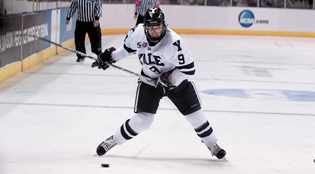 loading
loading
Ice age Bob HandelmanForward Brian O'Neill ’12 (above, in the first-round NCAA tournament game with Air Force), whom coach Keith Allain ’80 called "the heart and soul of our team," led a balanced Bulldog offense with 20 goals and 26 assists this season. His ejection from the NCAA East Regional final on a controversial call contributed to Yale's season-ending loss to Minnesota–Duluth. View full imageShort memories are not always desirable in hockey. None of the Bulldogs’ upperclassmen, for instance, could forget the sting of their season-ending loss to BC last spring—nor did they wish to forget. Early this season, the players took to wearing T-shirts bearing a slogan that would be their rallying cry throughout the year: “Unfinished Business.” Jimmy Martin was one of the main men behind the T-shirts, which, in the end, is not surprising. When Allain first took over at Yale, Martin was the first recruit his coaching staff targeted and the first to commit to Yale in the Allain era. Born in St. Louis, Martin left home at age 15 in pursuit of higher levels of hockey and attended three high schools in three states, a teenage odyssey that “made me grow up,” he says, and grow into a leader. In May of his junior year at Yale, his teammates elected him captain. A defensive defenseman whose offensive upside only peeked its head out in his senior year, Martin pretty well fit what came to be the mold of an Allain recruit: fit, fast, and awfully small. Martin was one of nine players on this season’s roster listed at 5-foot-9 or below. Yet that’s a list that includes five of the team’s top eight scorers in 2010–11, including Little, who’s soon to graduate, and Brian O’Neill ’12 and Andrew Miller ’13, who were numbers one and two in scoring and will be back in the fall. On a team that had nine seniors and could spread the burden of leadership around, it was Martin who emerged above all as the voice of the team’s conscience and identity, and not just as a T-shirt designer. The Bulldogs, by finishing second to upstart Union in the ECAC regular-season standings, earned the benefit of a bye week before taking on St. Lawrence in the conference quarterfinals. Asked how the team kept its focus during two idle weeks, Allain offered much of the credit to his captain. Martin, mindful of Yale’s flat performance in an ECAC quarterfinal loss to heavy underdog Brown the year before, was eager for meetings with his coach, “all initiated by him, about getting people ready, making absolutely sure people were ready,” Allain said. “It was really important to him and to this senior class.” And that senior class, in turn, was clearly important to Allain, not least because it was the first group he and his staff lured to Yale. In the emotional moments after their college careers had been closed, a downtrodden Allain told a roomful of reporters, “I’m not ready to eulogize this class just yet.” But if you had asked five people in that room who Yale’s star was this season, you might have gotten five different answers, not all of them from the Class of 2011. For all the Bulldogs’ talent and accomplishments in recent years, no Eli has been among the ten finalists for the Hobey Baker Memorial Award, given annually to college hockey’s most outstanding player, since Chris Higgins ’05 in 2003. Taylor’s later teams, including his best, the 1997–98 squad that brought home Yale’s first-ever ECAC title, were top-heavy on the stat sheet, with stars such as Higgins and Jeff Hamilton ’01 (a two-time Hobey Baker finalist) bearing much of the scoring load and Ray Giroux ’98 (Hobey finalist as a senior) anchoring the defense. Allain disdains the term “secondary scoring,” which means scoring contributions from more than just top players or a top line, but his teams are notable for it: this season, seven different Bulldogs reached double-digit totals in goals, and four earned more than 40 points. On the ’97–’98 ECAC-winning team, those numbers were two and one, respectively. Such a balanced model may prove difficult to sustain, but it also may be the ideal approach for a school like Yale, where elite athletic recruits aren’t automatically a good academic fit. As long as he remains at Yale, Allain will have to contend with the twin handicaps familiar to Ivy League coaches, whose schools don’t do athletic scholarships and do set the academic bar high. Brooke, who sees a bright future for Yale hockey, doesn’t want to hear it. “Who says outstanding athletics and outstanding academics can’t go hand in hand?” he asks.
|
|